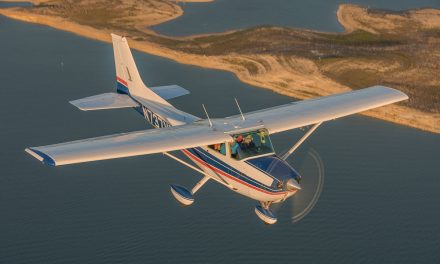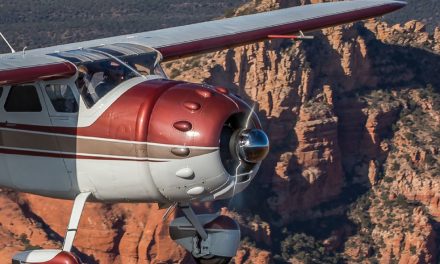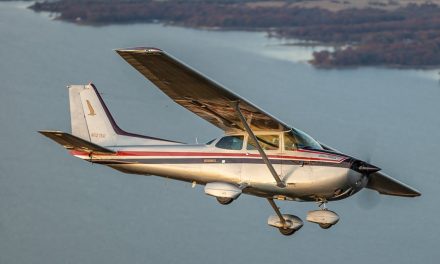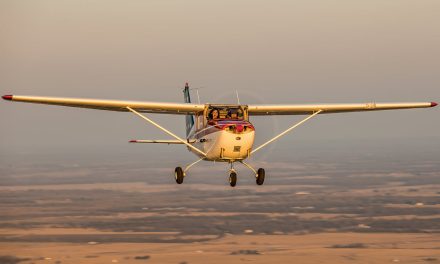 “Why sure, you can spin a 140. Used to do it all the time back in ’46.”
“Why sure, you can spin a 140. Used to do it all the time back in ’46.”
The old-timer leaned forward in his chair, and we all knew that was our cue to listen closely. “I guess we must’ve spun just about everything back during the war; Stearmans, AT6s, PT-22s, even a P-51 once, though I don’t think I’d want to do that again. The 140 wasn’t any different. After all, it was an airplane, wasn’t it?” Jack was almost as much of a cliché as the worn, brown, leather flight jacket he wore, a fighter pilot grown old, if such a thing is possible.
Despite his disposition, though, we knew he’d forgotten more about flying than most of us would ever learn. Pushing 60 now, the eyes were going, the hands weren’t quite as steady, and the mind wasn’t as quick, but he’d been there and done it all—Ploesti, Normandy, Berlin.
“Trick was to leave the power on, pull ‘er up to about 40 degrees of pitch, kick the left rudder to the floor at the break, and pull the yoke all the way back,” Jack explained. “She’d roll right into the spin smooth and clean, and you’d get ‘er out by just chopping throttle, easing the yoke forward, and reversing the rudder. Don’t you boys go trying that, though. It’s legal, but you’d probably just screw it up and break the airplane.”
The ink was barely dry on my private license back in 1967, but the rental Cessna 140 parked in front of Mutual Air Service in Hawthorne, California, N81074, seemed a perfect invitation to conventional gear. The airplane rented for $4.80 an hour dry, and with old Jack as my instructor for an extra $3.50 an hour, I went on to check out in the 140, log a dozen hours, and discover the joys and pitfalls of tailwheels. And, yes, we did spin it.
Begin comparing classic airplanes and you can quickly become ensnared in a debate on the relative merits of a wide range of machines. It seems that there are few givens among classic aircraft.
Nevertheless, one of those few is the ageless Cessna 140. Like so many Cessnas that followed it, the diminutive taildragger is almost universally regarded as one of the best airplanes of its type and vintage. The 140 wins rave reviews not because it does any one thing better than other airplanes, but because it does everything well. In short, it’s among the best at being average or better.
Cessna 120s and 140s were that company’s answer to the imagined post-war boom in private aircraft. The 120, intended as a bare-bones trainer, was essentially a budget version of the 140 with no flaps, rear side windows, or electrical system in the initial iteration. The ragwing 140 and its later all-metal version, the 140A, were built from 1946 through 1950. Collectively, there were just under 7700 Cessna 120s and 140s built, about 300 of which are still flying.
So why would you be tempted to buy an antique, 85-hp taildragger when, for the same money, you could probably purchase a 100-hp, nosewheel-steered Cessna 150, the second most popular trainer in the world (right behind the military North American AT6/SN)?
Fun might be a good reason. Fun was motivation for many of the minimum airplanes of the late ‘40s, and the little Cessna’s fun quotient was high. I learned to fly in a Piper Colt, about as bland a trainer as there was at the time, and my first flight in the 140 was like a breath of fresh air.
Len Rudrud of Screaming Eagle Aviation in Santa Paula, CA, chose his Cessna 140 simply because, like Everest, it was there. Rudrud is a retired American Airlines captain who knows a thing or three about aviation and also owns a 58TC Baron as hangar mate to his 140. Rudrud bought the Cessna several years back. Since then, he’s polished and cleaned, faired and smoothed, upgraded and improved it. “The airplane was already a jewel when I bought it,” he admits. “I just made it better.”
Rudrud allows, “I’ve been flying complex aircraft all my life, three and four-engine jets and turboprops and multi-engine pistons with turbochargers, pressurization, and constant-speed props, and the nicest thing about the 140 is that it doesn’t have any of that stuff. The 140 is almost ridiculously uncomplicated. It’s a simple airplane for a simple mind, almost like flying a piece of Kleenex.”
No Kleenex ever looked quite this attractive. We make it a policy to test the best examples of a model we can find, and Rudrud’s gem certainly qualifies as a best-of-type. Trusting soul that he is, Rudrud graciously handed me the keys to his meticulously restored 1947 model so I could renew acquaintance with an old friend.
Pure airplane: no frills, no ups, no extras. Just double-strutted wings, two doors, fixed gear, fixed prop, manual flaps, a bullet proof C85-12 Continental engine out front, and a yoke, throttle, and rudders to control the whole package. As Rudrud suggests, what could be simpler?
Climb into the small seats through the narrow door, and you can’t help but notice that creature comfort is minimal unless pilot and copilot are very small creatures. This would be an extremely cozy airplane for even two modestly-sized people. The cabin is only about 39 inches across at the elbows and about as tall. Rudrud’s bird weighed in at 1005 pounds against a 1450-pound gross. Payload with a full 25 gallons in the tanks was 290 pounds. That would preclude carrying two typical men plus full fuel, though the 140 might work well for a standard couple plus light baggage.
The test airplane was appropriately equipped for operation in and around the Los Angeles Basin, and that meant a 720/200 navcom and a transponder/encoder. Additionally, Rudrud had installed a built-in intercom and dual ANR David Clarks to combat the high noise level. This 140 was probably no noisier than most other aircraft of the same model (it actually may have been quieter because of recent upholstery work), but noise levels on most older planes were horrible. The test bird’s decibel count came in at around 99—typical of the vintage.
Since the whole design philosophy of the 140 was based on the KISS (keep-it-simple-stupid) principle, there’s a minimum of controls to worry about—a good thing, since the panel isn’t large enough to house a major avionics stack. In view of the airplane’s overall simplicity, its landing light was something of a surprise, an electrically powered retractable design that folded up into the left wing when not in use.
Engine start is straightforward and taxi is conventional for a taildragger. The rudder pedals are spring-connected to the tailwheel and, accordingly, directional control on the ground is reasonable if not exactly positive. One bit of advice in no-wind conditions: Keep the yoke full back to maximize pressure on the tailwheel and improve steering authority. The cowling slopes slightly downhill from the pilot, and the normal, three-point attitude isn’t too steep. There’s little need for S-turning to see what you’re about to hit.
Push the power up for takeoff and not a lot happens. The engine out front makes more noise, but acceleration isn’t overly noticeable. Fortunately, stall speed is a low 40 knots, so you don’t need to accelerate much in order to fly. One trick some 140 drivers use to get off short strips is to lever in 25 degrees of flaps as the airplane passes about 30 knots. This will help launch you into the air, but you’ll need to bleed off the flaps to climb most efficiently.
Nothing happens very fast in a 140, especially not climb. I saw about 500 fpm on a warm day with full fuel and 190 pounds of me aboard. The book suggests a 640 fpm climb in sea level/gross/standard conditions at 70 knots. Up at 8000 feet, climb is down to 330 fpm at an optimum 64-knot Vy.
Though the 140 came equipped with a mixture control, many pilots never bothered to use it. Travel on the standard control was only about an inch, making fine-tuning difficult. Normal cruise heights were below 5000 feet, and leaning the mixture had little effect at such low altitudes. Fuel burn was less than 5 gph at a max cruise 2400 rpm. And two 12 ½ -gallon wing tanks provided about four hours endurance plus reserve.
At the 140’s characteristic 90-knot cruise speed, you could plan for 360 nm legs. Lower power settings reduced burn slightly, but the loss of airspeed was almost directly proportional, so there was little advantage. Typical of most normally-aspirated singles, optimum altitude (where 75 percent is all there is) works out to about 6500 feet, though the manual lists service ceiling as 15,500. It’s hard to imagine a reason to climb that high in the low and slow cruiser.
By any measure, the 140 is a delightful airplane in the sky, possessed of a quick roll rate (for a Cessna), a responsive elevator, and even a reasonably effective rudder. I wasn’t inclined to spin Rudrud’s bird during my flight, but the old CAA regulations suggested I could have. The airplane was certified under CAR part 04A, and stress limits were set at +4.57 and -2.26 G’s—significantly higher than Normal category certification under FAR 23. Despite the 140’s pristine condition, however, time takes an often insidious toll on airframes, and I’d be reluctant to subject this one to potentially high G-loads.
Still, it was a joy to roll the 140 left and right to 60 degrees of bank. The airplane loves to maneuver and makes its pilot feel right at home, much more so than the later 150. There’s little question Cessna made substantive improvements to the 150’s airframe and powerplant, but control response didn’t improve with other upgrades.
Slow flight is almost ridiculously sloooowww. Pull in full flaps, add power to hold altitude at the absolute minimum airspeed, and you’ll be plugging along at less than 35 knots. Even power-off stall is 39 knots.
With such a low stall speed, you can feel right at home flying final at 55 knots. Unlike most other Cessnas, the 140’s wing flaps seem to have little effect on glide characteristics, but that doesn’t really matter since the plane can plant and stop in 300 feet or less. Like most other late ‘40s two-seaters, the 140 is happier at the bottom of its speed envelope than at the top.
Truly fanatical 140 owners sometimes indulge themselves with elaborate mods. The 100-hp O-200 Continental engine will practically bolt right into the C85’s engine mounts, and many owners make the upgrade at overhaul time. Some have even stepped up to the O-235 Lycoming, which isn’t a bolt- on conversion. Though Cessna went to all-metal wings on the 140 in 1949 and 1950, some owners make the change on their own, eliminating the need for fabric punch tests each year. Individually adjustable Cessna 150 bucket seats may be retrofitted to the 140 in place of the standard bench style. Wheel extensions improve gear geometry, and most 140s have transitioned from the old Goodyear brakes to the heavier-duty and less touchy Cleveland wheels and brakes.
Good Cessna 140s are worth exactly what you can get for them, and standard Aircraft Bluebook price quotes don’t mean much to prospective buyers. Trade-A-Plane is perhaps a better pricing source. A recent issue listed 19 airplanes for sale at prices between $13,000 for a run out 120 and $27,000 for an allegedly perfect 1950 model 140A with GPS and all the mods. Keep in mind; however, those are asking prices rather than getting prices.
For the record, Rudrud’s own 1947 Cessna isn’t for sale, though he’s always eager to show it off to anyone with a sincere love for the type. Just don’t ask him to spin it.
Specifications and Performance – 1949 Cessna 140A
All specs and performance numbers are drawn from official sources, often the aircraft flight manual or the manufacturer’s web site. On used aircraft, common sources of information are Jane’s All-The-World’s Aircraft or RVI’s Aircraft Bluebook Price Digest.
Specifications
Engine make/model: Continental C85-12
Horsepower @ altitude: 85 @ SL
TBO – hours: 1800
Fuel type: 73 octane
Propeller: Two-blade fixed
Landing gear type: Fixed/Conv
Gross weight (lbs): 1450
Std empty weight (lbs): 890
Useful load – std (lbs): 560
Usable fuel – std (gal/lbs): 22/132
Payload – full fuel (lbs): 428
Wingspan: 33’ 4”
Height: 6’ 3”
Wing area (sq ft): 159
Wing loading (lbs/sq ft): 8.7
Power loading (lbs/hp): 17.1
Wheel size: 6.00 x 6
Seating capacity: 2
Cabin doors: 2
Cabin width (in): 39
Cabin height (in): 40
Performance
Cruise speed (kts): 94
Fuel Consumption- 75% (gph): 4.8
Range (75%): 360
Best rate of climb, SL (fpm): 680
Service Ceiling (ft): 15,500
Stall – Vso (kts): 39
TO (ft): 500
Ldg (ft): 230





